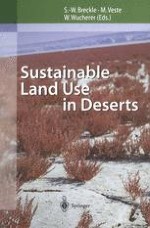2001 | OriginalPaper | Buchkapitel
How Grazing Turns Rare Seedling Recruitment Events to Non-Events in Arid Environments
verfasst von : Suzanne J. Milton, Thorsten Wiegand
Erschienen in: Sustainable Land Use in Deserts
Verlag: Springer Berlin Heidelberg
Enthalten in: Professional Book Archive
Aktivieren Sie unsere intelligente Suche, um passende Fachinhalte oder Patente zu finden.
Wählen Sie Textabschnitte aus um mit Künstlicher Intelligenz passenden Patente zu finden. powered by
Markieren Sie Textabschnitte, um KI-gestützt weitere passende Inhalte zu finden. powered by
When livestock numbers are high in relation to the percentage of the vegetation comprising preferred forage plant species, and where no provision is made for occasional livestock withdrawal during periods of flowering and seed set, grazing will deterministically lead to the near-eradication of certain forage plant guilds from rangelands. Recruitment events for long-lived plant species, and even for ephemeral plants, are uncommon in arid (<200 mm/a−1) environments and are closely tied to weather sequences that favour the particular plant species by promoting first seedset and then germination and seedling survival. Preferred forage plant species, whether ephemeral or perennial, with or without soil-stored seed banks, decrease or disappear from areas where the grazing regime, by preventing seed-set, turns potential recruitment events to non-events. This chapter provides evidence for the rarity of recruitment events in an important forage plant Osteospermum sinuatum (DC) T. Norl. (Asteraceae) in South African Karoo shrubland and analyzes population structure and seedling densities in protected (9.4 SD 7.7 seedlings m−2) and grazed areas (0.02 SD 0.3 seedlings m−2) 2 years after a sequence of years that favoured seedling recruitment. Seedling to adult ratios were 5:1 in protected areas and 0.7:1 in grazed areas on the same ranch. Although refuges have potential to increase seed availability in heavily grazed rangelands, seed input to sink populations will be constrained by the dispersal mechanism. Seeds of O. sinuatum are tumbled over the ground by wind, and an exponential decrease in seedling density with distance from the seed source (n= 25, r = −0.699, p <0.001), indicated that most seeds are dispersed within 5 m of the source. When grazing control by fencing is not economically feasible, many small refuges (such as provided by spinescent and toxic plants) may be more effective than seed plantations in maintaining key forage species in rangelands.
